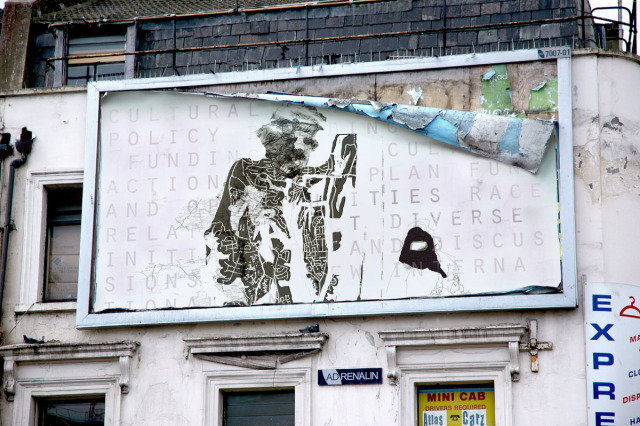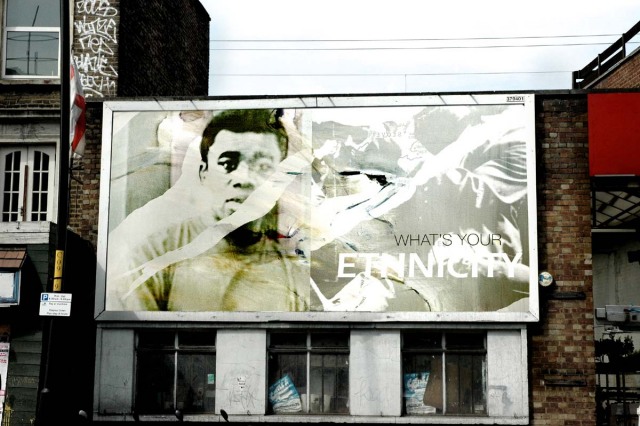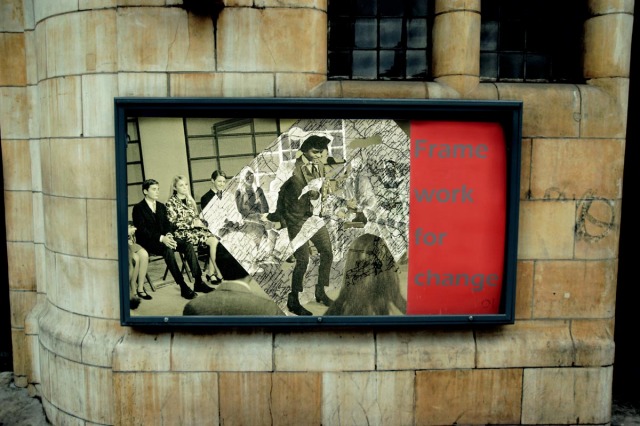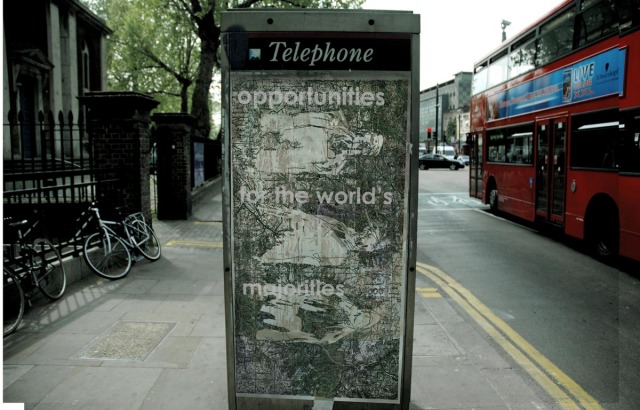The Circular Story of Black Arts Policy
Richard Hylton's recent book The Nature of the Beast: Cultural Diversity and the Visual Arts Sector indicts the multiple failures of state backed multiculturalism through a fine-combed history of visual arts policy in the UK. In this adaptation of a talk given at the launch of the book, Geoff Cox reads off the charges
Underlying my relative privilege to offer some comments on Richard Hylton’s The Nature of the Beast: Cultural Diversity and the Visual Arts Sector:
 A Study of Policies, Initiatives and Attitudes 1976-2006, is my apparent lack of cultural diversity. The book states the obvious in this regard: that issues around cultural diversity are not the concern of Black and Asian people alone (p.29).
Hylton's book traces changes in attitudes towards cultural diversity reflected in policy – not through an orthodox history but by citing key moments and detailed examples as the result of extensive research. As such, history is not linear or teleological, but revealed to be a construction, and one in which vested interests are served. Post MacPherson, the Arts Council makes an easy target in this respect – and its instrumental attempts to illicit changes on a substructural level look clumsy to say the least.[1] The book attempts to recover the ruins – in the manner of what the preface refers to as 'cultural materialism' – to understand the diversity of the ways in which culture is produced.[2] This is a political endeavour because social processes are embedded in culture and diverse in character.
Cultural diversity thereby requires a diverse cultural interpretation to account for the ways the changing categories of 'culturally-diverse arts' have been historically applied. The book points to the many failures to learn from, and to build upon, the previous mistakes of various 'diversity' initiatives. At the present time, for example, Arts Council England’s decibel initiative [http://www.artscouncil.org.uk/aboutus/project_detail.php?sid=3&id=79] stands out as a particularly regressive initiative revealed to be a return to older discredited policies associated with the 'ethnic arts'. The general argument of the book is that neither historical nor political forces are acknowledged sufficiently well (or rendered in their full complexity) in such initiatives, and that the various successes and failures of the policies reveal wider social trends and attitudes. As the full title of the book indicates, the focus is on ‘policies, initiatives and attitudes 1976-2006’ in the UK’s visual arts sector. Therefore it should be no surprise that it does not engage with other art fields, cultural theory, current preoccupations with Islamism, anti-globalisation movements, or with radical energies outside of art. Its focus is decidedly true to its title.

Image: Illustration by Nick Brooks
I have tried to summarise a number of problems raised by the book, that roughly correspond to its structure (eight in all). I aim to stress its polemical aspects. Although the stated intention of the book is to provide detail to allow others to draw their own conclusions, my point is that, despite this, and the use of qualifying terms like 'arguably', there are powerful arguments contained here. This should come as no surprise to those already familiar with Richard Hylton's work.
1. The problem is wrongly identified
The book begins with an elaboration of the context and history of decibel, an initiative launched in 2003 by Arts Council England to support and raise the profile of artists of African, Asian and Caribbean descent in England. Whilst the book recognises the unprecedented support it offers, at the same time it gives a clear indication of the sense in which '”cultural diversity” is short-changing those whom it purports to support and letting those it claims to challenge off the hook?' (p.16)
The claim is that there is a marked lack of debate about purpose and effectiveness. For instance, the book identifies the perception of the need for special training for those with 'special needs' to help those who otherwise could not help themselves. The problem here is that the excluded rather than the excluders are addressed.
Critical attention is also required to examine 'success' as much as 'failure' for some Black artists and the ways in which institutions spend their allocated funds. Considering the huge levels of support, why are some artists celebrated above others? The book quotes Rasheed Araeen:
If we are still seriously concerned with racism in the visual arts, we should look for it not only in the failure but also the success of black artists. Why are some artists ignored while others are promoted and celebrated? This question must be answered by the institutions that are now spending millions of pounds in support of black artists.(p.29)
Participation becomes both a quantitative and a qualitative issue. The overriding assumption however remains that Black art is somehow lacking and therefore requires special attention or subsidy. Those who need most challenging are somehow simply ignored, and cultural apartheid is legitimised (p.30), leaving little changed in terms of the institutional racism at the heart of cultural provision.
2. The problem is separated out
The book traces the term cultural diversity back 30 years or so to the Arts Council's 1976 report by Naseem Khan, 'The Arts Britain Ignores', which used the term 'ethnic arts'. What is interesting is that the term; 'ethnic minority arts', at this time goes beyond race and colour (p.33) – but all the same reflects a Western European world view. In terms of community relations more generally, the report also emerges in parallel to the challenge to the elitism of art through the community arts movement at that time, but doing so in such a way that it remains subordinate to real Art (made by those disconnected from the community) and therefore is easily dismissed.

Image: Illustration by Nick Brooks
The report argued for a separate provision for 'ethnic minority arts' on the grounds that otherwise they will be ignored (p.34). In contrast, Rasheed Araeen in ‘The Art Britain Really Ignores' (of 1984) describes this as a 'recipe for cultural separatism' (p.36). Cultural policy is seen to follow broader political attempts to tackle race relations – the white establishment trying to find a solution to the 'black problem' (also quoting Araeen, p.38). The function therefore of ethnic art can be seen to celebrate and preserve the parent culture in contrast to the emerging force of first generation Black British artists who were not engaged in 'ethnic art', but 'Black Art' informed by an anti-racist politics responding to the increased recognition of racism in society at large. [3]
3. The problem is discriminated for
In the early 1980s, the GLC's so-called 'loony left' concern for the rights of women, gays, and Blacks, meant there was an unprecedented dedicated fund for 'ethnic arts'.[4] Despite an awareness of the danger of marginalisation, the 'ethnic arts sub-committee' defended their use of positive discrimination. Yet mainstream funding of the arts remained relatively untouched. The paradox is that policies both establish and support development but, at the same time, lead to further ghettoisation. This is a fundamental issue that the book addresses: how to support something that is perceived to need support without further inscribing the need. The book states:
In light of the GLC's arguably prescriptive patronage of Black visual arts, such failures are rendered all the more troubling. For by insisting on initiating (and controlling) much of its activity relating to Black visual artists, it could be argued that the GLC not only pigeon-holed but also contributed to the negation of Black artistic practice within the visual arts sector.(p.52)
And how are Black artists positioned within such schemes? Their 'creativity is neutralised' as Eddie Chambers put it, or as Rasheed Araeen states: 'What was once a radical challenge to the dominant culture, is now becoming a separate category to be managed and controlled by black functionaries.' (both quoted in the book, p.53)
The book suggests that the cultural diversity agenda suffers similarly:
... the GLC's patronage of (willing) Black artists to promote 'anti-racism' arguably compares to the Arts Council's latter-day support of (willing) Black artists to promote "culturally diverse arts" as part of its cultural diversity agenda.(p.56)
However, this is not to underestimate the importance of the GLC’s considerable challenge to the mainstream through symbolic and financial support, and not least in contrast to the Arts Council's 'more cautious approach', maintained despite its power to take ‘positive’ action (p.50).
4. The problem is essentialised
In parallel to its drive to embrace enterprise, the Arts Council of Great Britain (as it was then called) underwent structural changes to support Black and Asian artists. The book treats such initiatives as paying 'lip-service' to change and begs the question of what actions actually result from action plans?
In the Arts Council’s 1989 report 'Towards Cultural Diversity', it was recognised that Black arts had received an unprecedented level of exposure and been featured in many important exhibitions, but these had been largely themed and group shows. Many of the major institutions remained simply indifferent and 'non-compliant', yet there was no corresponding threat of sanctions from the Arts Council despite its undoubted power to take such measures. Instead, and this is the significance of the report, it developed a strategy that 'resolved to find a “place for Black Arts organisations and groups”' (p.63). Evoking the GLC's earlier project to develop The Roundhouse in Camden as a Black Arts Centre, what the Arts Council had in mind was the development of inIVA (The Institute of New International Visual Arts) to provide opportunities to those from the 'world's majorities' (p.67) – the phrase is a neat inversion and seemingly demonstrates a more integrationist approach.
Yet again, the paradox arises between a policy towards integration on the one hand, and the stated necessity for an independent Black arts sector on the other (p.65). In contrast, the launch of the journal Third Text is introduced as an example of a significantly more 'progressive' intervention, with its stated ambition to contest:
... racism and sexism inherent in the dominant discourses on art and culture, but also of those essentialist assumptions which define 'black art' as simply the work of artists who happen to be black analogous to the notion of feminist art as any work produced by a woman artist.(quoted on pp.67-8)
5. The problem is conditional
If Black art was to be accepted by the mainstream and allowed to enter into the canon of art history there remained conditions. Although Black artists gradually gained greater visibility either through the gallery circuit or through self-organisation, survey shows (such as Into the Open, 1984, From Two Worlds, 1986, and The Other Story, 1989, amongst others) were often the only way to achieve exposure despite the acknowledged pitfalls of such initiatives – as necessarily racialising artistic practice. The reception of these shows makes interesting reading, as does the institutional politics. For instance, we are told the ICA's exhibition The Thin Black Line, 1985, arises from the fact that (and quoting Lubaina Himid): 'The GLC had threatened to withdraw its considerable contribution to the ICA if something black did not appear in that financial year' (p.77).
The motives for the many exhibitions of this kind can be seen to be dubious – a combination of political expediency and liberal posturing as Eddie Chambers put it, and indicative of the inability of the gallery system to accept Black people as equals (p.81). Clearly some people are more equal than others. The book suggests a certain amount of complicity from artists and curators as a result of the funds and opportunities on offer, and far too few dissenting voices.
6. The problem is deferred
A separatist agenda emerges through a policy of apparent inclusion. The contradiction is evident in the work of the cultural diversity unit of the Arts Council (formed in 1991) leading to the now overt separatist agenda of decibel that reflects the social inclusion agenda of New Labour (by 2003). This is disappointing, (as stated earlier), in contrast to earlier attempts to 'integrate' cultural diversity into, and across, the work of its departments. What is left is a Cultural Diversity Action Plan that sadly has no plan of action to effectively tackle racism in the arts (p.102). In a long line of reports, 'Framework for Change' (published 2001), states that despite the stated success of the
Chris Offilis, Anish Kapoors, and Salman Rushdies [note the odd use of plurals] [...] The arts world cannot shut its eyes to the strictures of the Stephen Lawrence Report or the legal demands of the Race Relations (Amendments) Act.(p.102)
This all sounds fine, but ironically, the framework for change is seen to be largely a return to an old framework that failed to elicit much change. Cultural diversity becomes a high priority for separate development and funding, but what is missing, according to the argument of the book, is a critical engagement with the wider and underlying social and economic conditions that give rise to institutional racism.

Image: Illustration by Nick Brooks
Like social inclusion policies in general, cultural diversity offers little threat to existing structures of exclusion (p.103). Clearly part of the problem here is that some art is considered more ethnic, more diverse, than other art. The term 'Black Art' is briefly examined with connection to this issue: initially associated with the Black Power movement (pan-Africanism), then largely recuperated by the white establishment to simply refer to art produced by 'Black' people (pp.95-6); replaced by a consensus view that Black Art simply refers to not-white art, with White Art as the default position. The problem lies with the reception of the term itself, not least in terms of hierarchy: who exactly is being referred to, and to what degree? By the late 1990s, the term Black Art was dropped for its alleged more overt political undertones and its lack of inclusion in not fully reflecting the 'panorama of cultural diversity' (p.101).
7. The problem is ever more institutionalised
The 'inIVA franchise', as a separate and targeted fund for the cultural diverse arts, is one consequence of the many shifts in policy. The important difference from other Arts Council revenue clients (such as AAVAA, Third Text and Autograph), was that inIVA was more clearly engineered from the top down – a product of the Arts Council itself and its engagement with 'new internationalism'.[5] The book takes issue with power relations on an international stage, particularly evident in the ways in which western 'globetrotting curators' select from around the world rather than working with those possessing 'local knowledge' (p. 108-9).[6] Power becomes ever more centralised at the very moment it appears to be devolved in the globalised art world.

Image: Illustration by Nick Brooks
Despite many excellent productions, inIVA has consistently attracted criticism: for instance, as a result of its relatively large public subsidy yet low public profile, its lack of entrepreneurial drive, the vagueness of its mission, and a perception of its 'bureaucratic institutionalisation of cultural theory' (p.114-5). The many criticisms, according to the book, have failed to consider that success or failure are inextricably linked to the broader cultural context within which these categories operate (p.116). Hence, the book argues that the inIVA/Autograph capital project (with its new building in Rivington Place, London) must similarly be placed within the broader context of policy reports, lottery funding and the politics of inclusion, and so on.[7] All the same, initial scepticism over having a fixed building based gallery understood as perpetuating a separatist agenda has been reversed, representing 'the extent to which the Art's Council's handling of so-called cultural diversity has arguably regressed' (p.121). Times have changed – and cultural diversity is now mainstream.
8. The problem is exaccerbated
But what does cultural diversity mean?[8] The final section of the book situates the discussion in the context of cultural policy more generally, with the relations between the state through the DCMS and the Arts Council brought ever closer. There is some irony in Christopher Frayling (the Chair of the Arts Council) warning against the perils of political control when the Arts Council's clearly submits to increasing populism and the privitisation of culture – and is prescriptive in itself. Contemporary art appears to be increasingly subject to either the marketplace or a form of social work ( carried out in the absence or failure of other social programmes).
The book casts the Arts Council's current commitment to 'cultural diverse arts' [sic] as a direct consequence of the government's social inclusion agenda. Of course, it is also the result of many years of policy building, but the intervention of the book is that this latest turn is ultimately based on racial separation, repeating earlier approaches that have historically been seen to fail.
Cultural diversity effectively negates the individual merit of Black artists:
... the provision of “racially” separate visual arts organisation and initiatives, will, almost certainly, for years to come, absolve white run publicly funded galleries of any need or responsibility to engage on any level, in any way, with the majority of Black British visual artists as individual practitioners of merit and worth.(p.15)
Foreclosure
To simply separate out and grant advantage to non-White people is an unsophisticated response, and fails to engage critically with the conditions that allow for exclusion/inclusion in the first place. For an oppressed group to simply imagine a better world with the oppressor removed is a problem because it fails to recognise how one identity position is infiltrated and mediated by the other.[9] What is required is something along the lines of a 'negation of negation': where something is negated, but then is seen to remain within its symbolic confines until it in itself is further negated.[10] Without this, a scheme like decibel represents an inverted form of racism wherein the 'Other' takes on an assumed superiority.[11] In effect, diverse identifications such as this represent an acceptance of a world order in which all alleged differences are not differentiated but homogenised.
Cultural diversity is simply not diverse enough in other words, or dialectical enough in my view, as it does not acknowledge its contradictions sufficiently. It is only too clear how current strategies are positioned along segregationist lines, and it is depressing for those that think contradictions productive to see that the disparate strategies have been harmoniously reconciled as ‘the cultural diverse visual arts’. This is the intervention of the book – taking issue with such a regressive turn.
If the book seems to offer circular arguments at times, this is part of the point: that the policies, initiatives and discussions around such issues have come full circle:
Since the 1970s, cultural diversity initiatives within the visual arts sector have arguably exacerbated rather than confronted exclusionary pathologies of the art world. There has been very little in the way of resistance to such initiatives over the past thirty years or so. [...] as evidence suggests, far from resisting or boycotting "culturally diverse arts" initiatives, Black artists have often appeared to be enthusiastically accepting of them.(p.131)
.What is being emphasised here is that change does not come from above, but from below, and only in this way can it be transformational.
Richard Hylton, The Nature of the Beast: Cultural Diversity and the Visual Arts Sector; 
A Study of Policies, Initiatives and Attitudes 1976-2006, ICIA, University of Bath, Bath, 2007
Footnotes:
[1] The MacPherson report of 1999 states the obvious: 'Any long-established, white dominated organisation is liable to have procedures, practices and a culture which tend to exclude or disadvantage non-white people.' [2] 'Cultural materialism' (an elaboration of historical materialism) is a term developed by Raymond Williams to understand the diversity of social and material production. [3] The backdrop to this includes the Brixton riots of 1981, and the history of the anti-racist movement charted in Paul Gilroy's There Ain't no Black in the Union Jack, London: Routledge, (first published in 1987).
[4] The GLC's local government policies of subsidised travel, housing, and equal opportunities in employment were in polar opposition to those of the Thatcher's Conservative government. London, under 'Red Ken', was both a 'nuclear-free zone' and an 'anti-racist zone'. [5] The book quotes Jean Fisher warning against 'new internationalism' becoming 'another buzz-word appropriated and twisted by the existing structures of power to sustain their own positions' (p.112). Distancing itself from 'new internationalism' as evoking a 'utopian structure for wholeness and coherence' (quoting its director at that time, Gilane Tawadros), the newly formed inIVA took a more flexible approach to its intellectual and artistic role, not least in its character as production agency not fixed to the gallery context.
[6] An example referred to in the book is Africa95: although taking issue with African art cast in modernist terms of primitivism, such an initiative 'could be interpreted as another kind of fetishisation of African Art' (p.111) – through the project it is possible to trace the movement from an anthropological understanding of fetish to an economic one (with reference to a more internationalised or globalised art market). Furthermore, it is suggested that as a direct result, publicly funded galleries became more and more interested in the work of Black artists from abroad rather than Black artists from Britain. [7] A polemical example offered is of Barclays Bank's £1 million investment in the inIVA/Autograph project in contrast to its earlier widespread rejection on the grounds of its support of the apartheid regime at the time of The Roundhouse project. [8] And how is culture defined here? It is a particularly ambiguous term encapsulating the anthropological sense but also the diversity of cultural production in which class difference is crucial. [9] Here I am paraphrasing Wendy Brown in States of Injury (Stanford: Stanford University Press, 1996, p.36). Clearly, the logic that we all start off equal and should therefore be treated equally is flawed too. [10] Slavoj Žižek likens this to the misunderstandings at the root of the Hegelian idea of 'negation of negation'. He explains that 'the gap that separates the negated system's “real” death from its 'symbolic' death is crucial: the system has to die twice' (in The Ticklish Subject: the Absent Centre of Political Ontology, London, Verso, 1999, p.72). [11] Here I am drawing on Žižek’s view of multiculturalism as a 'disavowed, inverted, self-referential form of racism which empties itself of all positive content' (ibid. p 216), wherein the 'Other' takes on the 'privileged empty point of universality', in Hegelian terms. For an example of this, see the most recent equal opportunities monitoring forms issued with an Arts Council 'Grants for the Arts' application pack.
Geoff Cox <geoff AT generative.net> is an occasional artist and projects organiser as well as currently lecturer at the University of Plymouth (UK) and Transart Institute (A). He co-edited Economising Culture and Engineering Culture (Autonomedia, New York, 2004 & 05), and is also a trustee of Kahve-Society and the UK Museum of Ordure
Mute Books Orders
For Mute Books distribution contact Anagram Books
contact@anagrambooks.com
For online purchases visit anagrambooks.com






